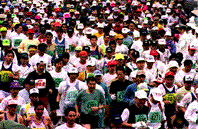 Science & Technology || Search || Back Numbers FROM WEIGHTROOM TO WORKROOM:
 The health boom among the general public is fueling sales of gel-type supplements. (Photo: Kyodo) Sports foods are taking off in Japan. These products are designed to allow people to take in nutrients while exercising or playing sports, or just on the go. Because sports foods are easy to carry, can be eaten anywhere, and are nutritionally sound, they are apparently well-suited to the lifestyles of modern consumers, who lead busy lives but are concerned about their health. Food and pharmaceutical manufacturers are trying to boost sales of these products by distributing them through a wider variety of channels, including convenience stores. A Liquid Breakfast on the Way to Work Most users of these gels are young office workers, both male and female--a group of consumers who tend to skip breakfast because they cannot find the time for it. Instead, they slurp down sports gels on the way to work, or at their desks while they are working. Nutritional supplements in solid bar form have been on the market for a long time, and are quite popular. But the gels offer a distinct advantage: They make taking in a meal as fast and easy as drinking a soft drink. Another factor in the popularity of gels is that they are readily available at convenience stores for between 200 and 300 yen (1.60 and 2.50 dollars at 120 yen to the dollar). One 37-year-old man says he often consumes these products on the way to or from the office, or at work. Sports gels also have a wide base of support from young women who are concerned about their health and appearance. In a survey by a leading manufacturer of the gels, about 13% of respondents said they used these products before, during, or after sports; 48% said they used them as meal substitutes; 10% said they used them as nutritional supplements; and 8% said they used them when they were suffering from a poor appetite or feeling run down. The survey results reveal that consumers use these products in a variety of ways to fit their lifestyles. Sudden Market Growth In response to this trend, pharmaceutical companies that manufacture sports foods are now trying to develop new products that appeal to a wider spectrum of consumers than in the past, when a narrower segment of competitive athletes were targeted. Highly active athletes, such as bodybuilders or track and field competitors, often use protein supplements to build up their muscle mass. These supplements are often sold as powders in cans--a form that average consumers find somewhat alien. One pharmaceutical manufacturer has now created a chocolate-flavored protein paste in a tube; the product came out early this year. The new protein paste is designed to be easy even for recreational athletes to use. Sales of tablet-type nutritional supplements at drugstores and convenience stores are also growing. The tiny bottles lined up on the shelves--vitamin B for rough, chapped skin, vitamin C for freckles, and so on--are designed to appeal to high-school girls and young female office workers. Drugstores in metropolitan areas are packed with young women in their teens and twenties looking for diet and beauty products, and the chain drugstores are extending their business hours to make things more convenient for these consumers. Sports foods used to be designed to support elite athletes engaged in rigorous competition. Now, by tailoring these products to accommodate modern-day people's needs for increased functionality and convenience, manufacturers of sports foods are supporting the lifestyles of a much broader range of consumers. These products have become star players in convenience stores' lineups, and their popularity can only be expected to grow.  Edited by Japan Echo Inc. based on domestic Japanese news sources. Articles
presented here are offered for reference purposes and do not necessarily
represent the policy or views of the Japanese Government.
Edited by Japan Echo Inc. based on domestic Japanese news sources. Articles
presented here are offered for reference purposes and do not necessarily
represent the policy or views of the Japanese Government.
|
